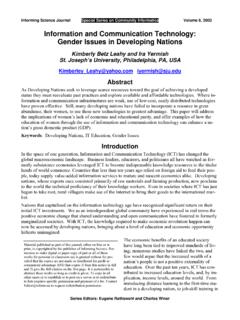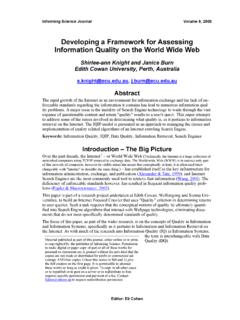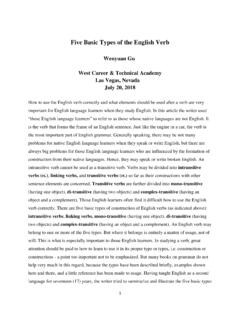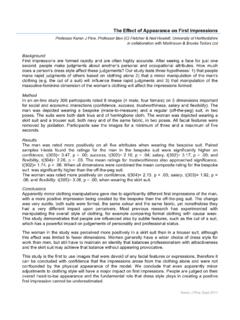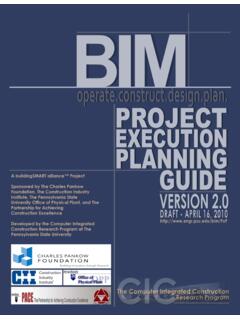Transcription of Five Roles of an Information System: A Social ...
1 Informing Science Developing Effective Organizations Volume 6, 2003. five Roles of an Information System: A Social Constructionist Approach to Analysing the Use of ERP Systems Linda Asken s and Alf Westelius Link ping University, Link ping, Sweden Abstract This paper presents a novel way of thinking about how Information systems are used in organisations. Traditionally, computerised Information systems are viewed as objects. In contrast, by viewing the in- formation system as an actor, the understanding of the structuration process increases. The user, being influenced by the ERP (Enterprise Resource Planning) system and giving it an actor role, thereby also confers agency on the ERP system; through its very use it influences actions and thus also the structure.
2 Based on a case study of ERP use in an ABB company over a decade, five different Roles played by the ERP systems were identified. The ERP systems acted as Bureaucrat, Manipulator, Administrative assis- tant, Consultant or were dismissed (Dismissed) in the sense that intended users chose to avoid using them. These terms are defined in the full text. The purpose of this approach here is not to animate the Information systems, to give them life or a mind of their own, but rather to make explicit the socially constructed Roles conferred on them by users and others who are affected by them. On this basis, it is possible to suggest how the Roles can help us open up new areas of exploration concerning the fruitful use of IT.
3 Keywords: Interpreting Information systems; Structuration theory; ERP systems; Information systems use; Actor; Social construction; Grounded theory; Case study; Longitudinal research Introduction This paper presents and discusses the influence that Information systems have on the organising process in an ABB company over a decade. It focuses on the interaction between the use of Information systems and the organising of the company. (The ABB Group, employing about 160,000 people in more than 100 countries, serves customers in power transmission and distribution; automation; oil, gas, and petro- chemicals; building technologies; and in financial services.)
4 The subsidiary company studied in this arti- cle produces large components for the power Material published as part of this journal, either on-line or in transmission and distribution sector.). print, is copyrighted by the publisher of Informing Science. Per- mission to make digital or paper copy of part or all of these Use and usefulness of Information systems differ. works for personal or classroom use is granted without fee pro- Previous research has attempted to establish vided that the copies are not made or distributed for profit or commercial advantage AND that copies 1) bear this notice in full causal relations between prerequisites for use, and 2) give the full citation on the first page.
5 It is permissible to such as technical quality, Information quality, and abstract these works so long as credit is given. To copy in all use, user satisfaction and impact (DeLone &. other cases or to republish or to post on a server or to redistribute to lists requires specific permission and payment of a fee. Contact McLean, 1992). Others have concentrated on the to request redistribution permission. relationship between user participation and use, or other indicators of system success. (Tait & Vessey Editor's Note: This paper replaces the paper originally published in Volume 4, Issue 3 pages 105-113 of the Informing Science Journal and first appeared as: Asken s, L.)
6 , & Westelius, A. (2000). five Roles of an Information System: a Social Constructionist Approach to Analyzing the Use of ERP Systems. In Proceedings of the Twenty-first International Conference on Information Systems, P. Weill, W. Orlikowski, S. Ang, H. Krcmar, and J. I. DeGross (eds.), Brisbane, Australia, December 2000, pp. 426-434. five Roles of an Information System (1988), DeLone (1988), Hartwick & Barki (1994), and McKeen, Guimeraes & Wetherby (1994) are ex- amples of quantitative research; Hirschheim (1985) and Westelius (1996) are examples of qualitative approaches). In all these studies the computerised Information system is viewed as an object; a technical construction that is to be used by people.
7 The Information system itself does not take an active part in the processes studied. In this article we take a Social constructionist stance (Berger & Luckman, 1967). In organisations, people talk of the Information systems as if they were intentional beings. Based on that observation, we explore the ways Information systems are perceived by their direct and indirect users. In actor network theory, Information systems are also considered to be actors interacting with other techno- logical and Social elements of the network, and descriptions of how the Information system acts as change agent or enemy to those who want change in the organisation have been provided (Hanseth &.)
8 Braa, 1998). Our exploration goes further and, building on Asken s (2000), proposes five Roles that an Information system may be allowed to take in an organisation: Bureaucrat, Manipulator, Administrative assistant, Consultant and Dismissed. Dismissed signifies an Information system that is not used at all by some or all intended users. These Roles are specific to the relation between the Information system and an individual or a group of people. Different individuals in the organisation may see the IS as having different Roles . Therefore, these Roles may coexist. We suggest that the way an Information system is used is influenced by the perceived fit between the structure in the company and the IS functionality on the one hand, and the user's perception of how the system is trying to influence the user's work on the other hand.
9 Structure is enacted or modified continuously (Giddens, 1984). One increasingly important part in this flow of thoughts and actions is the plethora of Information systems that surround us (Orlikowski & Ba- roudi, 1991; Orlikowski, 1992). The Information systems may be used in a way that matches or does not match the organisational structure and business logic. We label this IS fit with structure. Individuals may also be directed or limited in their actions by the Information system or employ it in ways that sup- port, but do not control, the way the work is performed. This we term Direction of control . We choose to place these two IS fit with structure and Direction of control as two dimensions with a range from Good fit to Poor fit, and from IS controls to Individuals control, and thus we can identify four different situations, represented by the quadrants, for the role the Information system may take rela- tive its user.
10 (See Figure 1) The Information system may be viewed as being in control and either used in a way that supports the existing structure routines and processes or in a way that clashes with them. In a similar way an Information system that is viewed as an optional support rather than as being in con- trol may be more or less in line with the existing way of working. Who is viewed as being in charge? This is to a large degree a subjective matter, a Direction matter of perception. The more knowl- of control edgeable the user is regarding the infor- mation system and the business proc- IS controls esses and tasks, the easier it is to gain a actions sense of control.
